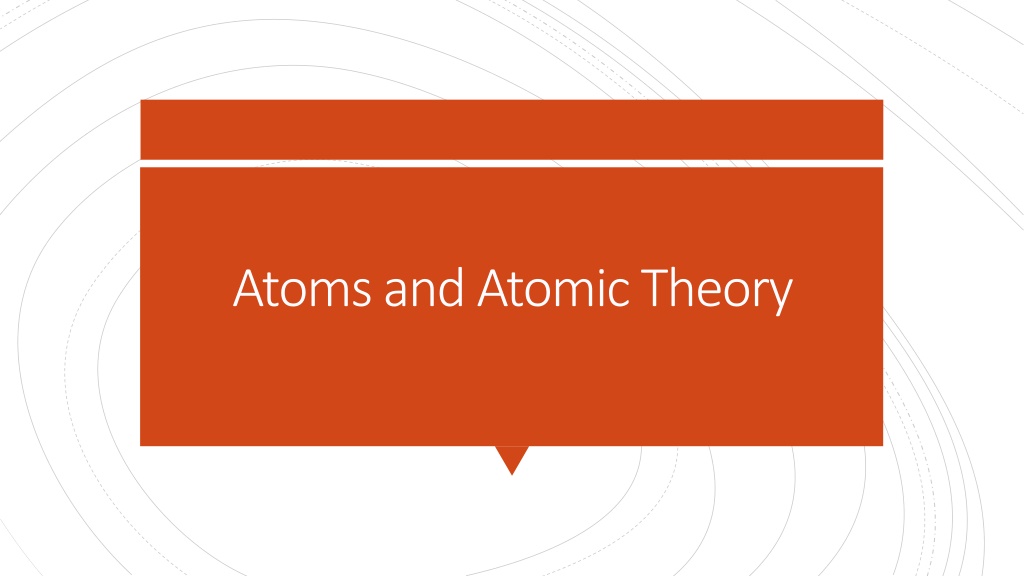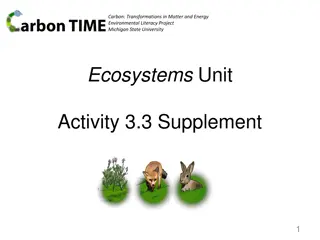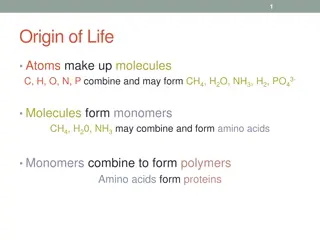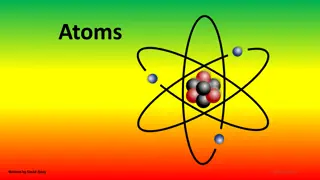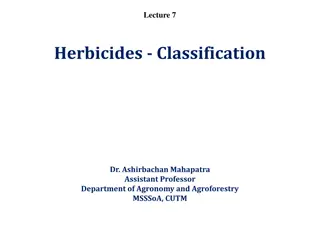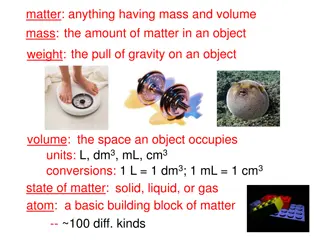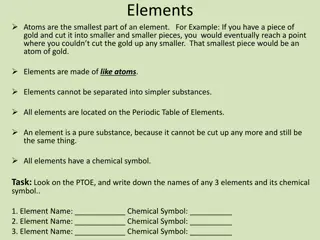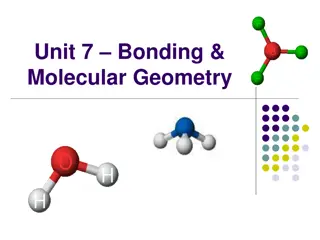Fundamentals of Atoms and Chemical Laws
Exploring the basics of atoms and atomic theory, this content delves into essential concepts such as the Law of Conservation of Mass and the Law of Constant Composition. It highlights key experiments by scientists like Antoine Lavoisier and Joseph Proust, illustrating how these laws govern chemical reactions and the composition of compounds. The interactive visuals provide a clear understanding of these fundamental principles in chemistry.
Download Presentation

Please find below an Image/Link to download the presentation.
The content on the website is provided AS IS for your information and personal use only. It may not be sold, licensed, or shared on other websites without obtaining consent from the author.If you encounter any issues during the download, it is possible that the publisher has removed the file from their server.
You are allowed to download the files provided on this website for personal or commercial use, subject to the condition that they are used lawfully. All files are the property of their respective owners.
The content on the website is provided AS IS for your information and personal use only. It may not be sold, licensed, or shared on other websites without obtaining consent from the author.
E N D
Presentation Transcript
Law of Conservation of Mass The familiar that it is hard to realize what a difficult riddle it posed for early scientists. process of combustion burning is so
In performed an experiment in which he heated a sealed glass vessel containing a sample of tin and some air. He found that the mass before heating and after heating (glass vessel + tin + air) were the same. Through further (glass vessel + tin calx + remaining air) experiments, he showed that the product of the reaction, tin calx (tin oxide), consisted of the original tin together with a portion of the air. Experiments like this proved to Lavoisier that oxygen from air is essential to combustion and also led him to formulate the law of conservation of mass: 1774, Antoine Lavoisier (1743 1794) The total mass of The total mass of substances present after a substances present after a chemical reaction is the chemical reaction is the same same as the total mass of as the total mass of substances before the substances before the reaction. reaction.
This law is illustrated in Figure, where the reaction between silver nitrate and potassium chromate to give a red solid (silver chromate) is monitored by placing the reactants on a single-pan balance the total mass does not change. Stated another way, the law of conservation of mass says that matter is neither created nor destroyed in a chemical reaction. Mass is conserved during a chemical reaction; (a) Before the reaction, a beaker with a silver nitrate solution and a graduated cylinder with a potassium chromate solution are placed on a single-pan balance, combined mass 104.50 solutions are mixed, a chemical reaction occurs that forms silver chromate (red precipitate) in a potassium nitrate solution. Note that the total mass 104.50 g remains unchanged. which displays (b) their the g. When
In 1799, Joseph Proust (17541826) reported, One hundred pounds of copper, dissolved in sulfuric or nitric acids and precipitated by the carbonates of soda or potash, invariably gives 180 pounds of green carbonate. Lawof Constant Composition This and similar observations became the basis of the law of constant composition, or the law of definite proportions:
To see how the law of constant composition works, consider the compound water. Water is made up of two atoms of hydrogen (H) for every atom of oxygen (O), a fact that can be represented symbolically by a chemical formula, the familiar H2O. All samples of a All samples of a compound have the compound have the same composition same composition same sameproportions by proportions by mass of the constituent mass of the constituent elements. elements. the the The two samples described below have the same proportions of the two elements, expressed as percentages by mass. To determine the percent by mass of hydrogen, for example, simply divide the mass of hydrogen by the sample mass and multiply by 100%. For each sample, you will obtain the same result:11.19% H.
1. Each chemical element is composed of minute, indivisible particles called atoms. Atoms can be neither created nor destroyed during a chemical change. DALTON s Atomic Theory 2. All atoms of an element are alike in mass (weight) and other properties, but the atoms of one element are different from those of all other elements. 3. In each of their compounds, different elements combine in a simple numerical ratio, for example, one atom of A to one of B (AB), or one atom of A to two of B (AB2).
If (assumption 1), then the same atoms must be present after a chemical reaction as before. The total mass remains unchanged. Dalton s theory explains the law of conservation of mass. If all atoms of an element are alike in mass (assumption 2) and if atoms unite in fixed numerical ratios (assumption 3), the percent composition of a compound must have a unique value, regardless of the origin of the sample analyzed. Dalton s theory also explains the law of constant composition. atoms of an element are indestructible If two elements form If two elements form more than a single more than a single compound, the masses compound, the masses of one of oneelement element combined with a fixed combined with a fixed mass of the second are mass of the second are in the ratio of in the ratio of small whole numbers. small whole numbers. Like all good theories, Dalton s atomic theory led to a prediction the law of multiple proportions.
To illustrate, consider two oxides of carbon (an oxide is a combination of an element with oxygen). In one oxide, 1.000 g of carbon is combined with 1.333 g of oxygen, and in the other, with 2.667 g of oxygen. We see that the second oxide is richer in oxygen; in fact, it contains twice as much oxygen as the first, 2.667 g / 1.333 g = 2.00. We now know that the first oxide corresponds formula CO and the second, CO2.(see in figure). that that all all we second second oxide in in oxygen oxygen as as the first first is is CO, CO, the for for the the second C C2 2O O4 4, ,C C3 3O O6 6, ,and we know know is is that oxide is is twice twice as as rich the first first. . If If the the possibilities possibilities second are andso soon that the the rich the are CO on. . CO2 2, , to the
Faraday discovered cathode rays, a type of radiation emitted by the negative terminal or cathode. The radiation crossed the evacuated tube to the positive terminal or anode. Later scientists found that cathode rays travel in straight lines and have properties that are independent of the cathode material (that is, whether it is iron, platinum, and so on). TheDiscovery of Electrons
A cathode-ray tube The high-voltage source of electricity creates a negative electrode at the left (cathode) and a positive charge on the electrode at the right (anode). Cathode rays pass from the cathode (C) to the anode (A),which is perforated to allow the passage of a narrow beam of cathode rays. The rays are visible only through the green fluorescence that they produce on the zinc sulfide-coated screen at the end of the tube. They are invisible in other parts of the tube. charge on the
Cathode rays and their properties (a) Deflection of cathode rays in an electric field. The beam of cathode rays is deflected as it travels from left to right in the field of the electrically charged condenser plates (E). The deflection corresponds to that expected of negatively charged particles.(b) Deflection of cathode rays in a magnetic field. The beam of cathode rays is deflected as it travels from left to right in the field of the magnet (M). The deflection corresponds to that expected of negatively charged particles. (c) Determining the mass-to-charge ratio, for cathode rays. The cathode-ray beam strikes the end m>e, screen undeflected if the forces exerted on it by the electric and magnetic fields are counterbalanced. By knowing the strengths of the electric and magnetic fields, together with other data, a value of can be obtained.
1. Most of the mass and all of the positive charge of an atom are centered in a very small region called the nucleus. The remainder of the atom is mostly empty space. 2. The magnitude of the positive charge is different for different approximately one-half the atomic weight of the element. TheNuclear Atom atoms and is 3. There are as many electrons outside the nucleus as there are units of positive charge on the nucleus. The atom as a whole is electrically neutral.
Explaining the results of -particle scattering experiments
(a) Rutherfords expectation was that small, positively charged particles should pass through the nebulous, positively charged cloud of the Thomson plum-pudding model largely undeflected. Some would be slightly deflected by passing near electrons (present to neutralize the positive charge of the cloud). (b) Rutherford s explanation was based on a nuclear atom. With an atomic model having a small, dense, positively charged nucleus and extranuclear electrons, we would expect the four different types of paths actually observed: 1. undeflected straight-line paths exhibited by most of the particles 2. slight deflections of particles passing close to electrons 3. severe deflections of particles passing close to a nucleus 4. reflections from the foil of particles approaching a nucleus head-on
Discovery of Protons and Neutrons
The nuclear atomillustrated by the helium atom In this drawing, electrons are shown much closer to the nucleus than is the case. The actual situation is more like this: If the entire atom were represented by a room, 5 m * 5 m * 5 m, the nucleus would occupy only about as much space as the period at the end of this sentence.
Properties Propertiesof Three of Three Fundamental FundamentalParticles Particles
The number of protons in a given atom is called the atomic number, or the proton number, Z. The number of electrons in the atom is also equal to Z because the atom is electrically neutral. The total number of protons and neutrons in an atom is called the mass number, A. The number of neutrons, the neutron electron carries an atomic unit of negative charge, a proton carries an atomic unit of positive charge, and a neutron is electrically neutral. Table presents the charges and masses of protons, neutrons, and electrons in two ways. number, is A-Z. An
